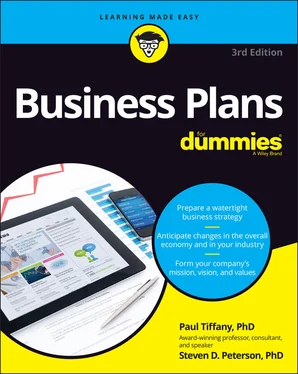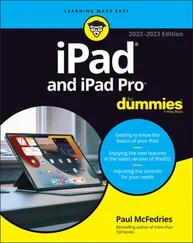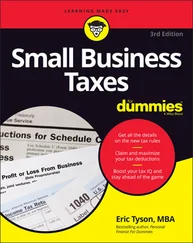Paul Tiffany - Business Plans For Dummies
Здесь есть возможность читать онлайн «Paul Tiffany - Business Plans For Dummies» — ознакомительный отрывок электронной книги совершенно бесплатно, а после прочтения отрывка купить полную версию. В некоторых случаях можно слушать аудио, скачать через торрент в формате fb2 и присутствует краткое содержание. Жанр: unrecognised, на английском языке. Описание произведения, (предисловие) а так же отзывы посетителей доступны на портале библиотеки ЛибКат.
- Название:Business Plans For Dummies
- Автор:
- Жанр:
- Год:неизвестен
- ISBN:нет данных
- Рейтинг книги:4 / 5. Голосов: 1
-
Избранное:Добавить в избранное
- Отзывы:
-
Ваша оценка:
- 80
- 1
- 2
- 3
- 4
- 5
Business Plans For Dummies: краткое содержание, описание и аннотация
Предлагаем к чтению аннотацию, описание, краткое содержание или предисловие (зависит от того, что написал сам автор книги «Business Plans For Dummies»). Если вы не нашли необходимую информацию о книге — напишите в комментариях, мы постараемся отыскать её.
Business Plans For Dummies
Business Plans For Dummies — читать онлайн ознакомительный отрывок
Ниже представлен текст книги, разбитый по страницам. Система сохранения места последней прочитанной страницы, позволяет с удобством читать онлайн бесплатно книгу «Business Plans For Dummies», без необходимости каждый раз заново искать на чём Вы остановились. Поставьте закладку, и сможете в любой момент перейти на страницу, на которой закончили чтение.
Интервал:
Закладка:
Everybody knows that the future is uncertain, so you need to talk about the ways your business world may be different in the future. List alternative possibilities for action, and in each case, describe what your company is doing to anticipate the changes and take advantage of new opportunities. Explain how your current resources might be rapidly transformed to meet new possibilities and what critical signals you will monitor to determine if and when such a pivot is necessary.
To prepare for change in your business world and to get info on how to think strategically about your company’s future, turn to Part 4.
Financial review
Your financial review covers both where you stand today and where you expect to be in the future.
Describe your current financial situation by using several standard financial statements. True, these statements don’t make for the liveliest reading, but the people who are interested in the financial part of your business plan expect to see them, and some of these folks will have a magnifying glass in their hands. For everyone else, make certain that your financial statements are referenced and support the assumptions and arguments that you make in the other sections of the business plan. The basic financial statements include the following:
Income statement: A list of numbers that adds up all the revenue that your company brings in over a month, a quarter, or a year and then subtracts the total costs involved in running your business. The total is your bottom line — the net profit that you make during the period.
Balance sheet: A snapshot of your financial condition at a particular moment, showing exactly what assets your company owns, liabilities that exist including money it owes, and its net worth.
Cash-flow statement: A record that traces the flow of cash in and out of your company over a given period, tracking where the money comes from and where it ends up. The cash-flow statement only tracks money when you actually receive it or spend it. Potential investors are particularly interested in when you plan to achieve “positive cash flow” status — that is, cash inflows become greater than outflow and you are not reliant on outside injections of cash to pay bills and stay solvent.
Your projections about your future financial situation use exactly the same kind of financial statements. But for projections, you estimate all the numbers in the statements based on your understanding of what may happen. These are called pro forma statements. Make sure to include all the assumptions you made to come up with your estimates in the first place.
To get a head start on your financial planning, flip to Chapters 11and 12.
Action plan
Your action plan lays out how you intend to carry out your business plan. It points out proposed changes in management or the organization, for example, as well as new policies or procedures that you expect to put in place. Also include any additional skills that you, your managers, and your employees may need to make the plan work. Finally, you want to talk about how you will generate excitement for your business plan inside your company, creating a culture that supports what you want to accomplish. Only then can you have real confidence that your business plan is going to succeed.
 If your plan is for a new venture or start-up, potential investors are especially interested in two key issues: Who are you (the specific individuals to whom they will give their money), and how will they get it back with a decent multiple (that is, the “exit strategy”)? They want assurances that you and your team have the chops to make the plan work, and that they will receive a financial reward that the risk of a new venture necessarily entails. This latter point means having a clear plan of when and how to monetize the new venture to the satisfaction of those providing the risk capital. Be sure you’ve considered these questions beforehand.
If your plan is for a new venture or start-up, potential investors are especially interested in two key issues: Who are you (the specific individuals to whom they will give their money), and how will they get it back with a decent multiple (that is, the “exit strategy”)? They want assurances that you and your team have the chops to make the plan work, and that they will receive a financial reward that the risk of a new venture necessarily entails. This latter point means having a clear plan of when and how to monetize the new venture to the satisfaction of those providing the risk capital. Be sure you’ve considered these questions beforehand.
For more background on how to make your business plan work, head to Chapters 16and 17.
Chapter 2
Understanding the Importance of a Business Plan
IN THIS CHAPTER
 Drilling down on your business idea
Drilling down on your business idea
 Planning for the past, present, and future
Planning for the past, present, and future
 Understanding the difference between strategy and tactics
Understanding the difference between strategy and tactics
 Identifying your audience
Identifying your audience
 Discovering the basics about potential investors
Discovering the basics about potential investors
A famous shoe company once proclaimed, “Just do it!” That sounds like good advice, so why waste time overthinking about what it is you need to do to accomplish your objectives? Just start moving and git ’er done, right?
No. Not good advice. Definitely not. Why? We will be the first to admit that planning is not a predictive science; indeed, far from it. But when you really drill down, you begin to realize that the point of planning (business or otherwise) is not to predict the future. The point is to better inform yourself and your associates about your goals and the levers that you can pull to move up and impediments that can thwart achievement. That is, planning is about the willful pursuit of knowledge, about thoughtful and rational consideration of all the elements involved in your defined quest, and how you can best navigate the surest path forward.
But aren’t there “unknowns” out there (even unknown unknowns) that can’t possibly be unearthed through any systematic approach to planning? Time, after all, is fleeting, especially in today’s hyper-charged global business environment — you linger, you lose; the race goes to the swiftest; and all that. And if so, then ditto — why not just put your head down and plow forward (and indeed save the money you just spent for this book)?
The answer, of course, is that yes, there are unknowns, greater today than perhaps ever before, and yes, it is often better to be first. But to reiterate, planning is about process as much as (if not more than) outcomes. This business-planning process, when done systematically and conscientiously as we describe it in the pages that follow, will greatly improve your chances of success by forcing you to consider, in sometimes excruciating detail, just what it is you’re up against — and how to leverage the advantages and circumvent the pitfalls that emerge.
A “good idea” is not a passport to success — lots of people have good ideas every day. In fact, the business terrain out there is littered with the desiccated remains of what once sounded like a “good idea” but never got beyond that point (anyone recall Pets.com?). Meanwhile, a good idea hitched to a sound plan for moving ahead is something that both experience and history have shown to be a highly positive factor — take a look at Amazon.com for just one example. Your purchase of this book is not an expense. Rather, it is an investment — and one that will yield dividends to those who take the process seriously. We don’t, and can’t, guarantee success with our suggestions for how to plan your business venture, but we do believe that the odds will improve substantially by following the guidelines we offer. So, OK, just do it — but first do your homework (and also eat your spinach); you won’t regret it. And as for that need for speed, just ask the second mouse at the cheese trap what it thinks of being first… .
Читать дальшеИнтервал:
Закладка:
Похожие книги на «Business Plans For Dummies»
Представляем Вашему вниманию похожие книги на «Business Plans For Dummies» списком для выбора. Мы отобрали схожую по названию и смыслу литературу в надежде предоставить читателям больше вариантов отыскать новые, интересные, ещё непрочитанные произведения.
Обсуждение, отзывы о книге «Business Plans For Dummies» и просто собственные мнения читателей. Оставьте ваши комментарии, напишите, что Вы думаете о произведении, его смысле или главных героях. Укажите что конкретно понравилось, а что нет, и почему Вы так считаете.












